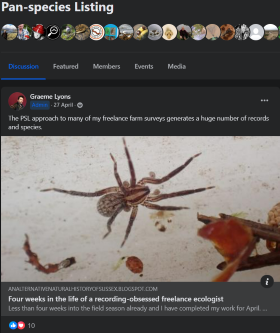To create a new list, you first need to be logged in. Having logged in, select Create New List from the My Lists menu.
Before entering the species on your list, you need to specify what type of list it is. This enables comparisons with other lists of similar types. Lists are defined based on a number of characteristics, which you are asked to choose between.
Location
For Pan-species Listing, the widest area your list can apply to is the 'PSL region', which is Britain, Ireland, the Isle of Man, and the Channel Islands combined. This is the location we recommend everyone to have for their main pan-species list, as it maximises the value you can get from comparing with other listers (e.g. to see your Top Targets). However, you can also choose smaller areas than this for a list to apply to, such as Ireland, Norfolk, Swillington Ings, or even your own garden. If a site doesn't already exist, you can create your own.
You can type in the name of the location to select from matching ones, browse the location tree and select one from there, or right-click on an existing one in the tree to add a new site below that.
When location is chosen you can then simply click the Create List button to create the list and start entering records, but there are some further options if required.
List period
This enables you to specify the time period over which your list operates. The options are Life (default) and Year. If you select Year, you will then need to select which year your list refers to.
List type
Whilst most lists will be for the default of All records, there are other specialist types of lists that some listers like to keep, e.g. self-found lists, and you can select from many options for list type.
Entering list records
Pan-species Listing provides two methods for entering the initial records onto a new list. These are:
- Create from scratch: this will display a checklist style entry form where you can tick all the species recorded, and enter additional details
- Copy from existing list: if you already have at least one list in the system then you can use this option to quickly create a new list, copying over records from the existing list.
Creating a list from scratch
For quick inputting of your list, you can simply tick the Seen? boxes next to the species names. However, for greater interest, particularly for people comparing between lists, we strongly recommend that you add a date and location (and maybe comments) against as many species as possible. Whilst this would ideally be for the first date you recorded the species for that list, it doesn't have to be. You can just type directly in each field and information will be saved immediately.
You can also tick the Sensitive? box for a species, so that the details of the records will not visible to other people on the website (although note that site administrators can always see these details). Please use this for rare breeding birds for example: see below for further discussion.
Creating a list by copying an existing list
For this option you need to first choose the existing list you wish to copy, from the dropdown list. Click the Create List button. You will then be prompted to confirm, and can also choose what details to copy: you can copy full details (i.e. date, location, comments and sensitive status) or just the species itself. For example, if you were creating a Norfolk county list based on your PSL life list, and you know that most of your first county records were not the same as the ticks on your main PSL list, it would be quicker to just copy the species itself. If you had done most of your recording within the county and therefore a large proportion of county ticks were actually British lifers as well, then copying all species details would work better. When the records have been copied and the new list created, you should use My Lists to update or delete all invalid records. Invalid records could include those species that you have never recorded in the new list area, or those where the species details refer to a record from a different area.
Notes
Self-found lists and other list types
As the list type is selected in conjunction with the other list characteristics above (location, period) this means that one can submit self-found county lists, self-found year lists and so on.
The definition of whether a species can be considered 'self-found' or not is one that has been discussed many times in the past and there may be various different ways of defining this. Pan-species Listing does not currently recommend any particular definition. We feel, however, that simplicity is best. In short, if you come across a species without having acted on prior information concerning the whereabouts of that specific individual of that species, we feel it can be considered self-found. This is perhaps too simplified to be clear under every circumstance, but it should do as a good start.
Sensitive records
Whilst the illegal collection of birds' eggs, orchids, rare ferns, etc. is now carried out by relatively few people in Britain, all keen naturalists know that it remains a potential threat to be aware of, and any sources of information are likely to be perused by collectors looking for information. Therefore, we would appeal to all listers to be sensible about the submission of details for particularly vulnerable species. We would recommend that if you wish to add a list entry of a rarer species, but have any concerns about the information being made public, you should either simply omit the details, or if you prefer, mark it as sensitive. The latter approach will mean that the details (location, date, and comments) of the record will not be visible to anyone else viewing the lists. The managers of Pan-species Listing will not disclose sensitive records to third parties; we are already used to dealing with sensitive records through other work. However, we would certainly encourage the proper submission of such records, such as to National Recording Schemes or Local Environmental Records Centres. As ever, we emphasise that the Pan-species Listing site is not a recording site, and really you should be submitting data to iRecord or similar systems.
Over and above the recommendations of listers, the managers of Pan-species Listing reserve the right to themselves conceal details of any record if they consider this appropriate.

